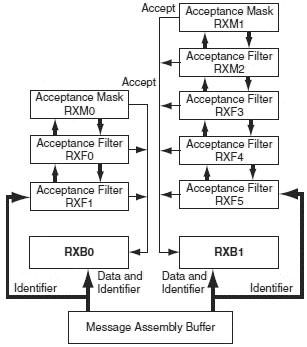Книга: Advanced PIC Microcontroller Projects in C
9.9.8 CAN Message Reception
9.9.8 CAN Message Reception
Reception of a message is a more complex process. The PIC18F258 microcontroller includes two receive buffers, RXB0 and RXB1, with multiple acceptance filters for each (see Figure 9.13). All received messages are assembled in the message assembly buffer (MAB). Once a message is received, regardless of the type of identifier and the number of data bytes, the entire message is copied into the MAB.

Figure 9.13: Receive buffer block diagram
Received messages have priorities. RXB0 is the higher priority buffer, and it has two message acceptance filters, RXF0 and RXF1. RXB1 is the lower priority buffer and has four acceptance filters: RXF2, RXF3, RXF4, and RXF5. Two programmable acceptance filter masks, RXM0 and RXM1, are also available, one for each receive buffer.
The CAN module uses message acceptance filters and masks to determine if a message in the MAB should be loaded into a receive buffer. Once a valid message is received by the MAB, the identifier field of the message is compared to the filter values. If there is a match, that message is loaded into the appropriate receive buffer. The filter masks determine which bits in the identifier are examined with the filters. The truth table in Table 9.3 shows how each bit in the identifier is compared against the masks and filters to determine if the message should be accepted. If a mask bit is set to 0, that bit in the identifier is automatically accepted regardless of the filter bit.
Table 9.3: Filter/mask truth table
| Mask bit n | Filter bit n | Message identifier bit n001 | Accept or reject bit n |
|---|---|---|---|
| 0 | ? | ? | Accept |
| 1 | 0 | 0 | Accept |
| 1 | 0 | 1 | Reject |
| 1 | 1 | 0 | Reject |
| 1 | 1 | 1 | Accept |
- 1.3.20 CAN Interface
- 9.9.7 CAN Message Transmission
- Применение функции scanf( )
- 8.4.2. Sending and Receiving Messages
- AIGLX — Eye Candy for the Masses
- Using Scanners in Fedora
- Session Message Block Printing
- Setting Message Delivery Intervals
- Virus Scanners
- 5.1.4. Boot Messages
- CHAPTER 9 Advanced PIC18 Projects — CAN Bus Projects
- 9.8 PIC Microcontroller CAN Interface




